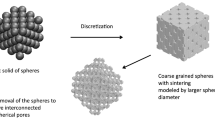Abstract
The formalism of (nonlocal) density functional theory provides an attractive way to describe the physical adsorption process at the fluid-solid interface. It provides numerical results of analytic precision in a small fraction of the time required by a simulation technique. In particular, the ability to model adsorption in a pore space of slit-like or cylindrical geometry has led to useful methods for extracting pore size distribution information from experimental adsorption isotherms. However, critical comparisons of experimental isotherms with the isotherms predicted by density functional theory have shown important differences when using the usual prescription for the nonlocal free energy density functional. It is clear that these differences would affect the accuracy of such pore size information. We show in this paper how a small modification to the mean field computation of the intermolecular attractive potential results in excellent agreement with experiment for the systems studied.
Similar content being viewed by others
References
R. Evans in Fundamentals of Inhomogeneous Fluids, edited by D. Henderson (Marcel Dekker, Inc., New York, 1992) pp. 85–175.
N.A. Seaton, Carbon 27, 853 (1989).
J.P. Olivier and W.B. Conklin, presented at First International Symposium on Effects of Surface Heterogeneity in Adsorption and Catalysis on Solids, Kazimierz Dolny, Poland, (1992).
C.M. Lastoski, K.E. Gubbins, and N. Quirke, J. Phys. Chem. 97, 4786 (1993).
P. Tarazona, Phys. Rev. A 31, 2672 (1985); Phys. Rev. A 32, 3148 (1985); P. Tarazona, U.M.B. Marconi, and R. Evans, Mol. Phys. 60, 573 (1987).
T.F. Meister and D.M. Kroll, Physical Review A 31, 4055 (1985); D.M. Kroll and B.B. Laird, Physical Review A 42, 4806 (1991).
W.A. Curtin and N.W. Ashcroft, Physical Review A 32, 2909 (1985); A.R. Denton and N.W. Ashcroft, Physical Review A 39, 4701 (1989).
R.D. Groot, Molecular Physics 60, 45 (1987); R.D. Groot and J.P. van der Eerden, Physical Review A 36, 4356 (1987).
C.M. Lastoskie, K.E. Gubbins, and N. Quirke, Langmuir 9, 2693 (1993).
J.P. Olivier, W.B. Conklin, and M.v. Szombathely in Characterization of Porous Solids III Proceedings, edited by J. Rouquerol et al., (Elsevier, Amsterdam, 1994), p. 81. Note: The curves were inadvertently reversed in Fig. 6.
J.P. Olivier in Carbon '94 Extended Abstracts, (The Spanish Carbon Group, Granada, Spain, 1994), p. 248.
W.A. Steele, Surf. Science 36, 317 (1973).
J.D. Weeks, D. Chandler, and H.C. Anderson, J. Chem. Phys. 54, 5237 (1971).
N.F. Carnahan and K.E. Starling, J. Chem. Phys. 51, 635 (1969).
S. Ross and J.P. Olivier in On Physical Adsorption, (Interscience, New York, 1964), p. 187.
Author information
Authors and Affiliations
Rights and permissions
About this article
Cite this article
Olivier, J.P. Modeling physical adsorption on porous and nonporous solids using density functional theory. J Porous Mater 2, 9–17 (1995). https://doi.org/10.1007/BF00486565
Issue Date:
DOI: https://doi.org/10.1007/BF00486565



